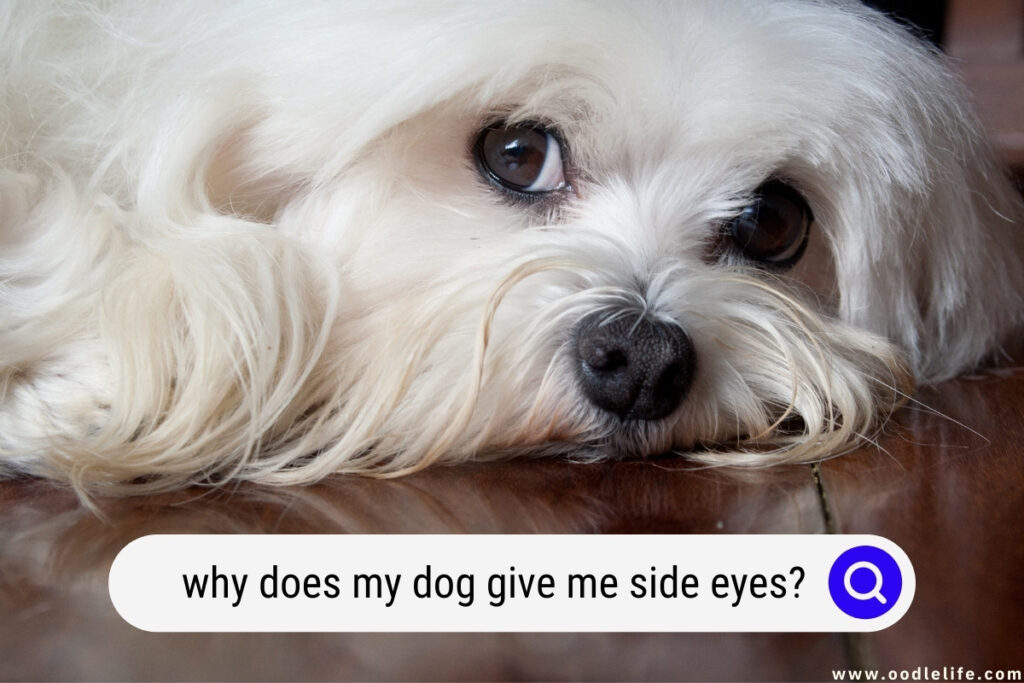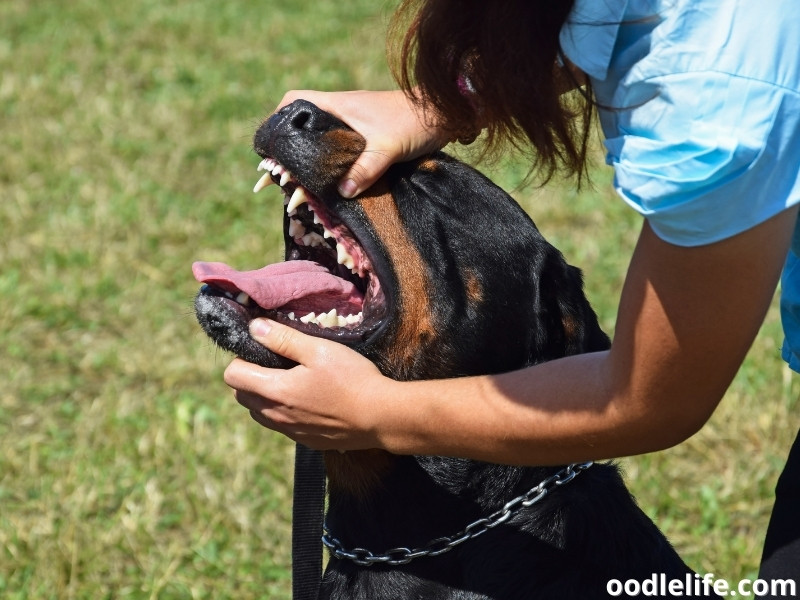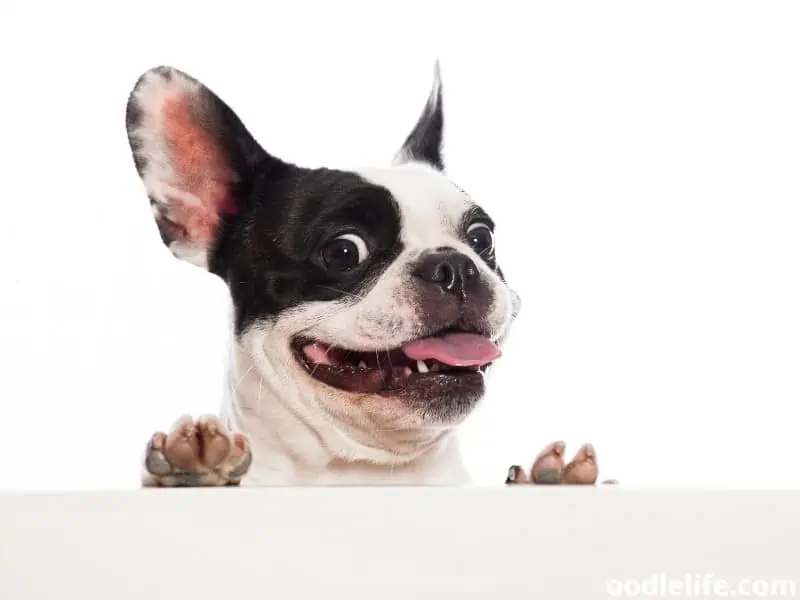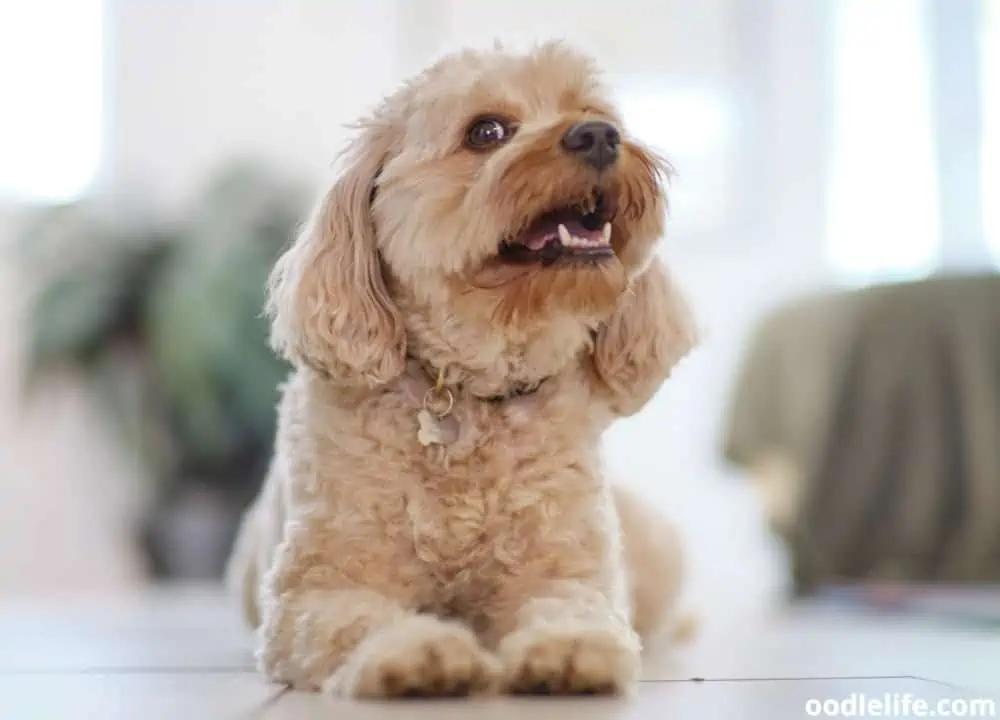Dog Side Eye Explained (Why Does My Dog Give Me Side Eyes?)
Every dog owner has seen their dog give them the side-eye. They’re playing with their toy, you walk by, and their eyes cut to you. When humans do this, it’s called the side-eye, but there’s another name for dogs: the whale eye.
If you catch your dog giving you the side eye, not to worry. They likely don’t mean any harm, and there are steps you can take to keep you and your pup happy and comfortable. Let’s get into what the dog side eye means and why your dog may give you whale eye.

Dog Side Eye Meaning
You know the moments when your pup gives you that side-eye glare. They may stay by your side if you have company over while glancing over at your guests.
Dogs will commonly give the side-eye, known as the whale eye, if they guard something important to them, such as a bone, toy, or their owners. Some refer to this look as “moon eye” or “half-moon eye” because half of their pupil is hidden in the outer corner with more of the whites exposed.
If your dog is giving you whale eye, this is a sign your dog is uncomfortable and warning you to back off. But how do you know if your dog is giving you a signal rather than casually looking your way?
Well, the head position is usually a good indicator. If a dog is crowded, overwhelmed, or in protective mode, the pup will look off to the side while keeping its head facing forward.
If your dog’s head is facing forward during their glance, this is a sign that they are quite literally keeping an eye on you or the subject bothering them.
To best understand your pup, you have to know their language. While you may not be able to communicate with barking, dogs give plenty of cues with their body language and facial expressions.

How To Know if Your Dog Is Giving You the Side Eye?
There’s a noticeable difference between a dog’s side eye and a typical gaze. Just because your dog looks at you from the sign doesn’t necessarily mean anything.
If your dog hears a noise as you walk by, they may glance to the side. In this case, they’re casually checking you out as you walk by.
Agitated dogs will not only have a “whale eye,” but their body will look tense, and your dog may tuck their ears back.
Your dog may give you this look as if they’re protecting something or simply want to be left alone.
The Fake Side Eye
Dogs are incredibly smart, and sometimes, they know how to train you just as much as you train them. There may be occasions where you see the whites of your dog’s eyes, and they aren’t warning you.
If your dog is begging for food or trying to get attention, your pup will give you those precious “puppy eyes.” Your dog isn’t stressed or uncomfortable, and instead, they’re actually trying to manipulate you.
According to a study, dogs have a muscle that allows them to raise their eyebrows and use them to show facial expressions.
After years of domestication, dogs have learned that it triggers a nurturing response to nearby humans when they raise their eyebrows. So, dogs learned that they have a better chance of getting what they want by looking apathetic.
Dogs may flash their “puppy eyes” and look at you from the front or from the side. If done from the side, the puppy eyes will look similar to the whale eye, but there are other differences.

Understanding Dog Facial Expressions and Body Language
Dogs have muscles on their face that allow them to make facial expressions similar to the way humans do. Your dog can express happiness, sadness, excitement, and fear all on its face.
Like humans, you can tell a lot about how a dog is feeling by looking at their eyes. If someone tells you one thing and their body says another, it’s clear what they’re really feeling.
Unlike humans, dogs can’t tell us how they feel. So, we have to rely more heavily on watching their facial expressions and body language than we do with one another.
Additionally, a dog’s tail and ears tell us a lot about their thoughts and feelings. So, if your dog is glancing over with relaxed ears, they are more than likely not sending you a silent warning.
However, if your dog’s ears are stiffer looking or are positioned toward the back of their head, this can be a sign of worry or suspicion. Because different breeds have varying ear shapes, it can vary some.
If you’re unsure of what your dog is trying to say to you with their eyes, looking at their full facial expression, ears, and tail can help.
Other signs your dog is agitated:
- Giving you or someone else a warning growl
- Showing their teeth if you get too close
- Tense body
- Tucked tail
Signs your dog is stressed:
- Growling, whining, or barking
- Licking lips
- Panting
- Yawning
- Pacing back and forth
It may be tempting to scold your dog for acting aggressively, especially if they’re growling. However, dogs use warning growls as a well to signal that they’re in distress and to leave them alone.
By scolding your dog, you are not only teaching your dog that growling is bad but that they shouldn’t give warnings. Unfortunately, this could cause your dog to skip the warning altogether and go straight to biting.
Just because a pup is growling doesn’t mean they’re aggressive. All dogs growl, bark, and whine to express themselves, which is good.
If your dog is showing signs of aggression, such as biting, when food guarding or guarding other objects, don’t resolve the issue on your own; consult a dog behaviorist.
What To Do if Your Dog Gives You the Side Eye?
If you notice your dog is giving you the side-eye, don’t worry. We all need time away from others, and sometimes, our facial expressions do all the talking.
Even though your dog is trying to warn you, they aren’t trying to threaten you. If you see your dog side eye you, it’s best to give your pup a little space.
Avoid approaching your dog while they are guarding something of importance, such as their toys, food, etc. It may even be best to leave the room and return once your dog finishes their food or playing with their toy.
Once you notice your dog is ready to leave their toy or has finished eating, they’ll likely go back to giving you puppy eyes.
After it’s clear your dog is done with the object they were protecting, you can take it away. It’s best to remove any important items with your dog in another room.

There may be times when you need your dog to abandon the item immediately. Let’s say you’re about to go to work and your dog is playing with a toy when they shoot you the side eye.
To distract your pup from their toy, offer a treat if they follow you to another room. From there, you can move the toy out of eyesight and put your dog in its crate. You can add the toy to their crate, but do so without your dog watching you.
You may also need to use treats to distract your dog in emergencies. If your dog is guarding something that is potentially dangerous or toxic, toss treats by them. Then, quickly scoop up the item and keep it out of your dog’s reach.
If your dog has a habit of giving the whale eye to guests, you have a few options. You can warn any people coming over that your dog is protective and to provide them with space. It may be best to remove your dog from the situation altogether.
When guests are over, and your dog is out, make sure your dog isn’t right next to you to ensure they won’t guard you.
It may not even be your own dog giving you the side eye. You may be the guest at someone else’s house and notice their dog tense up and glance over.
As you would with your dog, give their dog plenty of space. They are telling you that they feel threatened by you. While you may feel tempted to go over and pet the dog or comfort it, this may create a more tense environment.

Conclusion
Dog side eye, also known as whale eye, moon eye, or half-moon eye, is your dog expressing a warning sign to back off. Canines use body language and facial expressions to do all of their talking, so it’s up to us humans to determine what they mean.
Not all dog side eye expressions are warning signals. Dogs with whale eyes will be tense and may have their ears tucked back. If you notice this, it’s best to give them some space.
